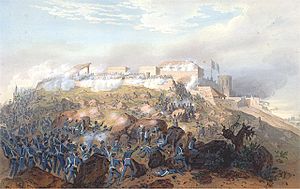Our website is made possible by displaying online advertisements to our visitors.
Please consider supporting us by disabling your ad blocker.
Battle of Chapultepec
| Battle of Chapultepec | |||||||
|---|---|---|---|---|---|---|---|
| Part of the Mexican–American War, Battle for Mexico City | |||||||
 Battle of Chapultepec, Carl Nebel, 1851 | |||||||
| |||||||
| Belligerents | |||||||
|
|
| ||||||
| Commanders and leaders | |||||||
|
|
| ||||||
| Strength | |||||||
| Total Army approx 2,000[1] |
1,232 total Mexican Army 832 soldiers in the Castle 400 soldiers from San Blas Battalion | ||||||
| Casualties and losses | |||||||
| Total: 862 |
c. 600 killed (most from San Blas Battalion) The rest were captured or wounded | ||||||
The Battle of Chapultepec took place between U.S. forces and Mexican soldiers holding the strategically located Chapultepec Castle on the outskirts of Mexico City on the 13th of September, 1847 during the Mexican–American War. The castle was built atop a 200-foot (61 m) hill in 1783, and in 1833 it was converted into a military academy and a gunpowder storage facility. The hill was surrounded by a wall 1,600 yards long.[3]
The battle was one of the most pivotal battles during the Mexican–American War as it paved the way to seize Mexico City and led to a decisive American victory. On the U.S. side the army was headed by General Winfield Scott, who led a force totaling 7,200 men. The Mexican side was led by General Antonio López de Santa Anna, commander of the Mexican army, had formed an army of approximately 25,000 men. Chapultepec Castle was defended by General Nicholas Bravo and his infantry of approximately 832 men, including military cadets of the Military Academy.[2] They defended the position at Chapultepec against 2,000 U.S. troops. The Mexicans' loss opened the way for the U.S. to take the center of Mexico City.
This battle proved to be significant win for American forces as it led to the eventual occupation of Mexico City. However, the story at Chapultepec cemented itself in Mexican history, as an act of bravery by six young cadets known as the Niños Héroes, who leapt to their deaths rather than die at the hands of American forces. According to legend, one of the cadets wrapped himself in the Mexican flag as he jumped so it would it would not be captured by the U.S. Marines.[4] Although it lasted only about 60–90 minutes, the battle has great importance in the histories of both countries.
- ^ a b Smith, Justin H. (Justin Harvey) (1919). The war with Mexico. New York: Macmillan. Retrieved 26 September 2018 – via Internet Archive.
- ^ a b Cite error: The named reference
Bauerwas invoked but never defined (see the help page). - ^ Fuller, J. F. C. (2007). Decisive battles of the U.S.A., 1776-1918. Lincoln, Neb: University of Nebraska Press. ISBN 978-0-8032-6003-0. OCLC 71348720.
- ^ Sandweiss, Martha A., Rick Stewart, and Ben W. Huseman, Eyewitness to War: Prints and Daguerrotypes of the Mexican War, 1846–1848. Fort Worth TX: Amon Carter Museum of Western Art 1989.
Previous Page Next Page


